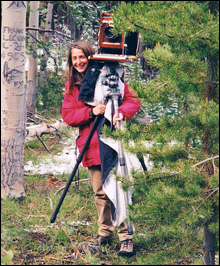
FORMALIST: McPhee composes her photos as she peers through the gridded glass of her Deerdorf 8x10 view camera.
|
Riding into Sawtooth Valley for the first time in June 2003, Laura McPhee stopped at the meeting of the Boulder and White Cloud Mountains and looked down on Central Idaho forest and cattle pastures, sagebrush and some houses, the Salmon River, and up the other side of the valley to the Sawtooth Mountains.Driving on, she recalls, “the first sign I saw was ‘Headwaters of the River of No Return.’ ” The Brookline photographer and MassArt teacher had been invited to the valley for an artist residency by the Alturas Foundation but had wandered into the opening credits of a Hollywood Western. River of No Return was one of the names they called the Salmon River because it was so wild and steep that for generations its white waters were a one-way route to the Pacific. But during eight visits over the next two and a half years, McPhee came to see it as a metaphor for sockeye salmon, once so populous, they say you could step across the river on their backs, but now struggling against extinction. It became a metaphor for the changes people impose on nature and the forward course of time. So “River of No Return” was the natural title for the photos that are on view at the MFA through September 17. They’re six by nine feet each because McPhee wants to sweep you up in the detail and drama of these 41 Idaho scenes. And the 48-year-old produces some of her best work yet.

This is one of those revisionist Westerns. Sure, you’ve got your obligatory prospecting and ranching, and a plucky but delicate pioneer girl coming of age, but there’s also heroic biologists and Native American scientists, reintroduced wolves, pine-killing beetles and new housing developments (boo, hiss). Her subjects reflect what her father, Pulitzer-winning journalist John McPhee, has called her “constant search for the dividing lines between altered and unaltered worlds.” In one photo, knobby bushes surround a roughhewn settler’s cabin from the 1920s while on a nearby hill stands a brand-new two-story cottage, the vanguard of a subdivision. In another, a hillside has been stripped naked to mine boulders that decorate suburban neighborhoods. Like one of those old homesteaders-versus-ranchers flicks, it gets your blood up.
And then there’s the awesome Valley Road wildfire, sparked when a burning cardboard box blew out of a barrel and torched 40,838 acres last year. An ashy road winds through charred hills and ghost-white trees. A dark plume of smoke rises into the angry gray sky from the still-green trees in the distance. In another photo, you can trace the fire’s path by the skeleton tree trunks left in its wake.
At the heart of “River of No Return” is Mattie, who was 12 when McPhee began photographing her in June 2004. She’s most often formally posed, centered in the darkness of her family’s barn. In the first portrait, the model-pretty girl wears a blue gingham shirt, rolled-up jeans, and an annoyed expression as she cradles one of the barred Plymouth Rock hens she raises. McPhee: “I feel like Mattie embodies both contemporary girlhood as well as girlhood that’s related to the 19th century.” She’s the child of biologists — Judy, who pads across her sunny front yard in her nightgown and holds an antenna to track radio-collared wolves, and Bob, who’s doing his darnedest to save the sockeye salmon.
Here’s Mattie in jeans and flip-flops holding up the dead turkey they raised for Thanksgiving dinner. And here’s Mattie in her gauzy blue eighth-grade graduation dress holding a dead Northern red-shafted flicker (as lovely as its name) by its outstretched wings. McPhee taps the old portrait tradition of incorporating props that symbolize a person’s nature or status. She produces lush images but falters when the symbolism boils down to pretty girl equals pretty bird and a simplistic lesson — something about blossoming womanhood and the inevitable fading of that beauty.
In two decades of work, McPhee has revealed a formalizing eye in her photographic family dramas, her portraits of adolescent girls, her landscapes in Iceland, Hawaii, Sri Lanka and New Jersey, her Indian tea-picker portraits, and (on view at Bernard Toale Gallery until July 1) her Calcutta mansion interiors. She arranges things head-on or in profile. Portrait subjects are often centered. Lines tend to run horizontal, vertical, or at basic angles — 45 degrees or half that. It’s as if everything had been gridded — and actually it has, because she peers through the gridded glass of her Deerdorf 8x10 view camera to compose her scenes. She seeks to bring order to the world. Her formalism is part of the deadpan photography style that’s everywhere lately: Surenda Lawoti’s firefighters in the “Document” show at Boston University’s Photographic Resource Center earlier this year; Neeta Madahar’s bird photos at the Danforth Museum; Rob Amory’s stark portraits at the Cape Ann Historical Museum through June 18; and throughout the catalogue Massachusetts College of Arts recently published of photos by its 2006 Bachelor of Fine Arts graduates.